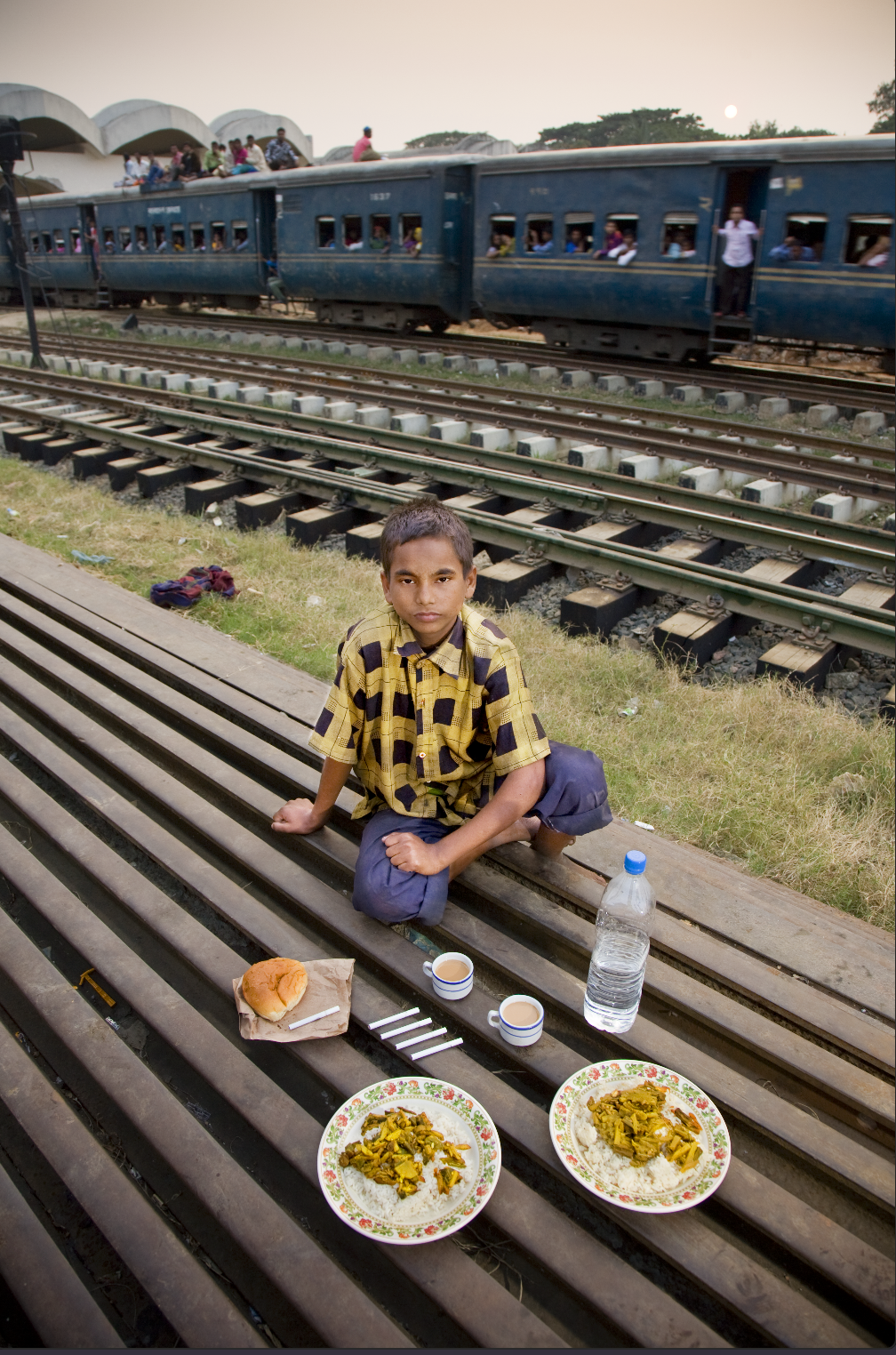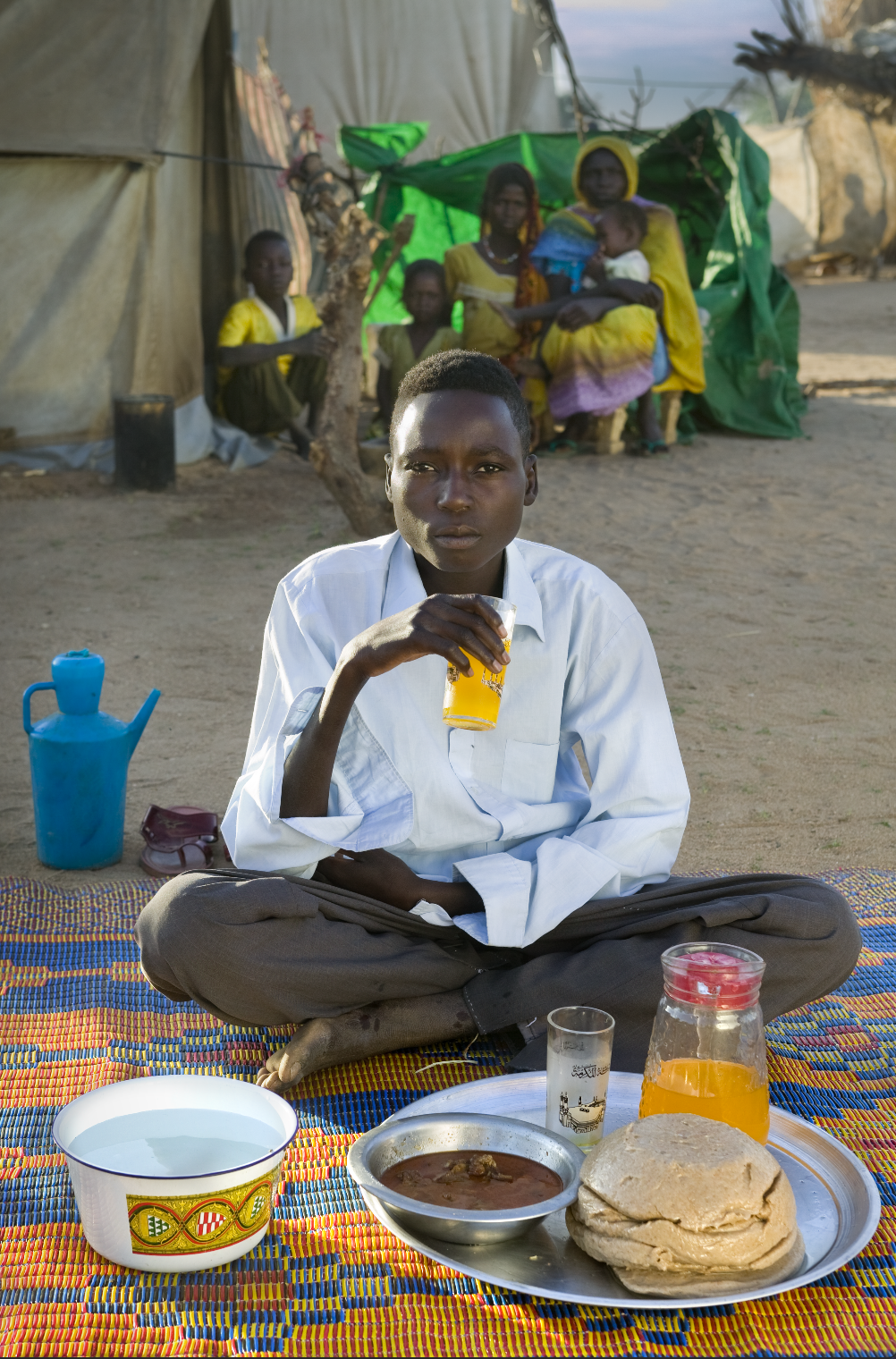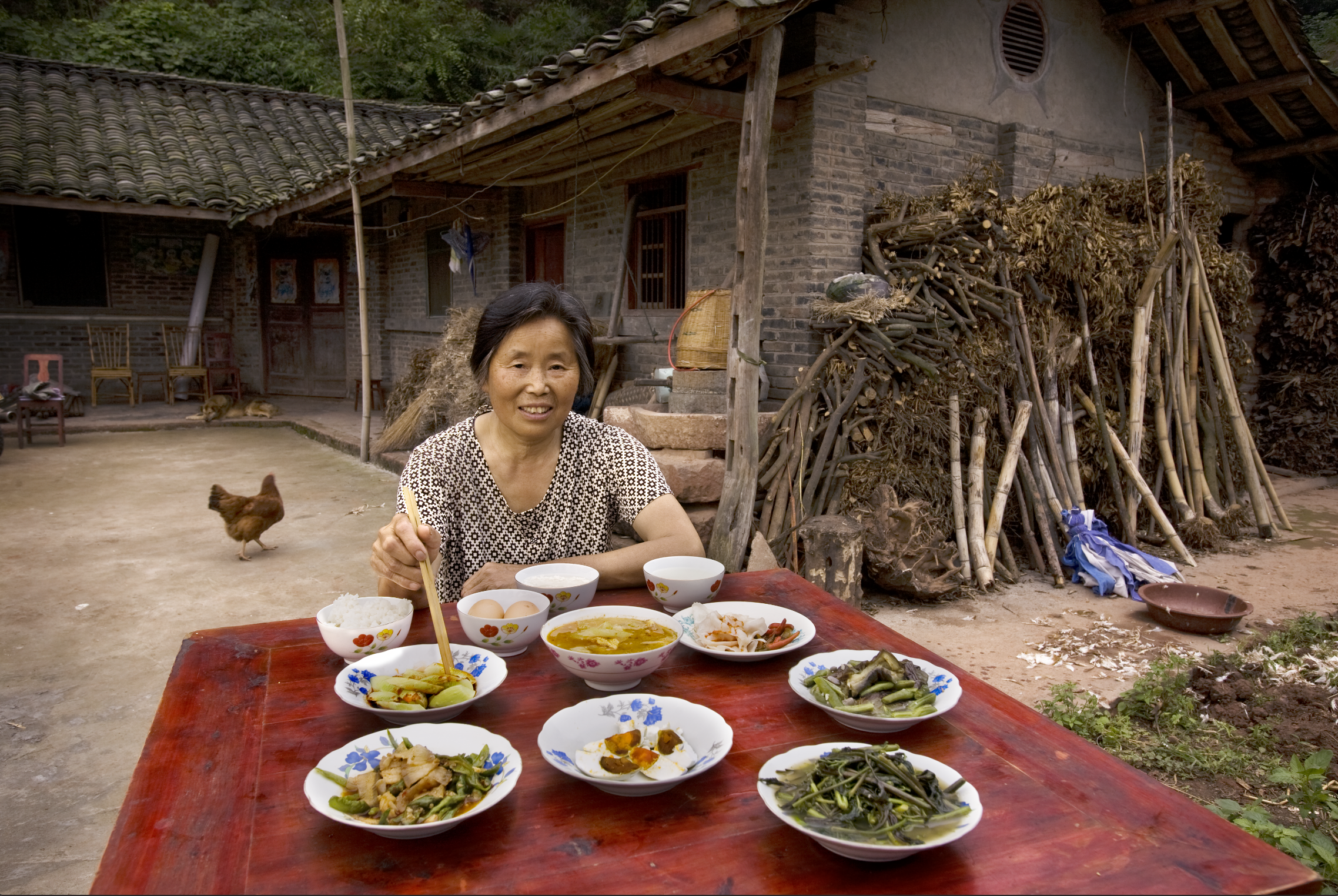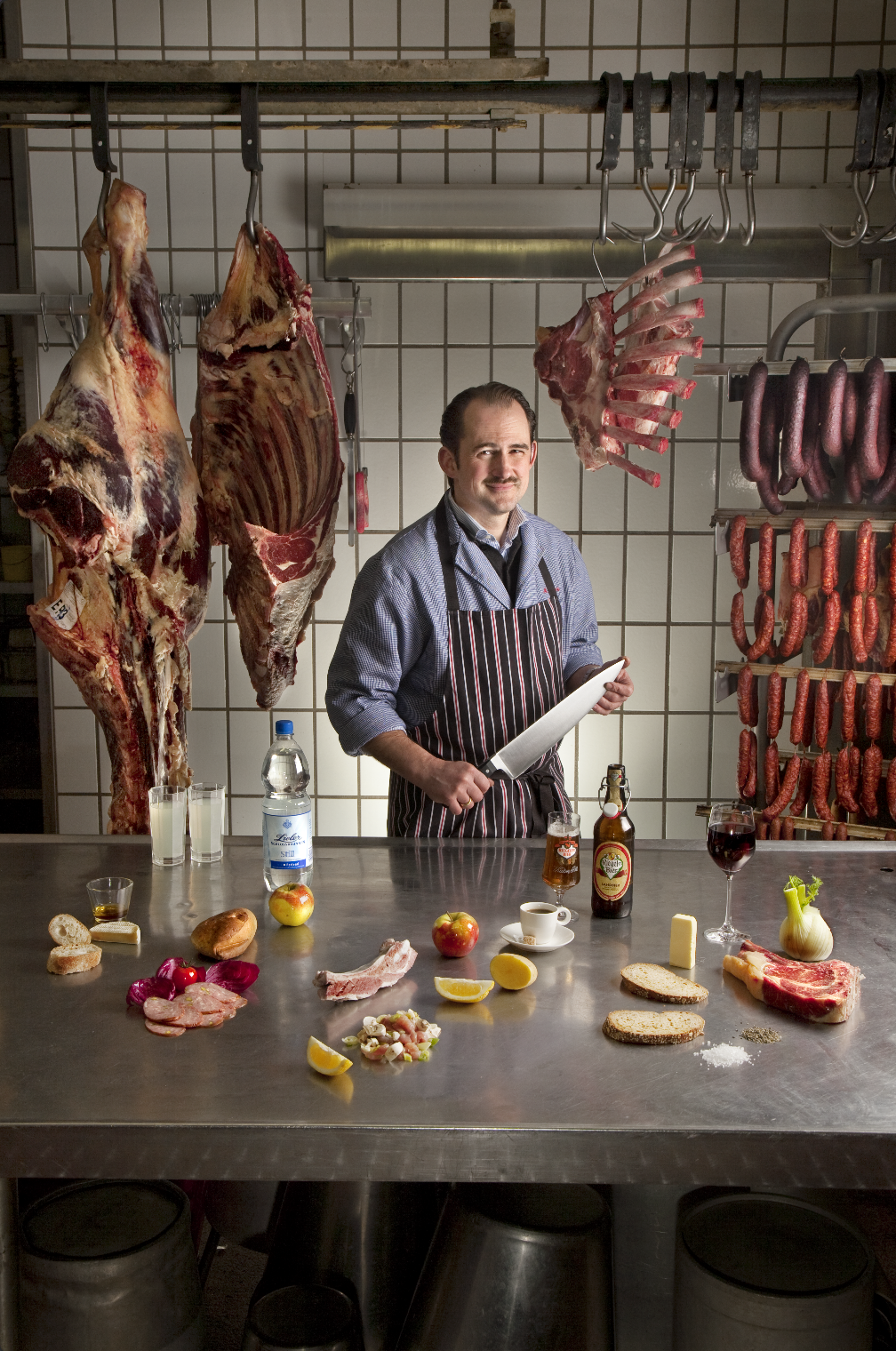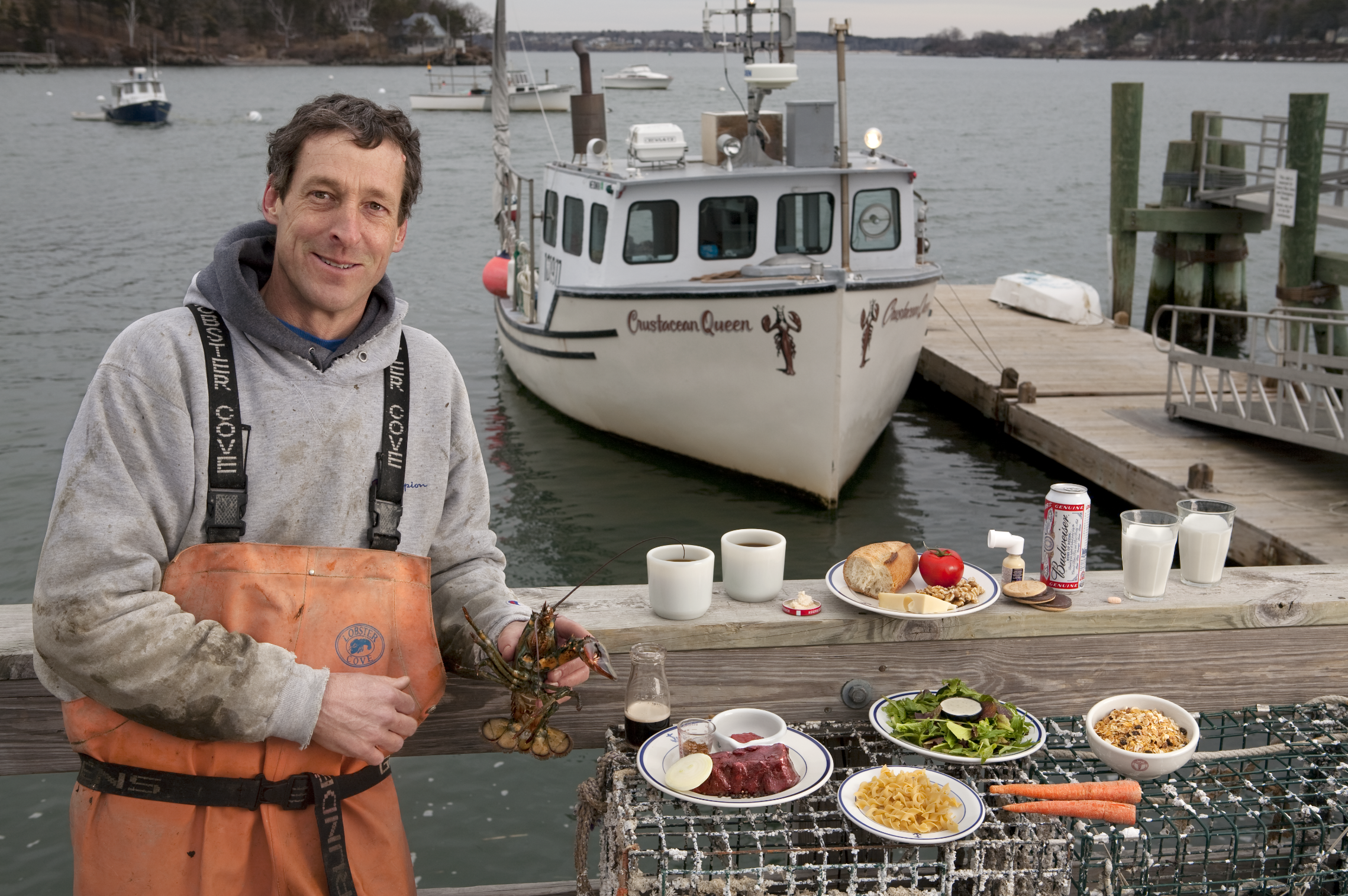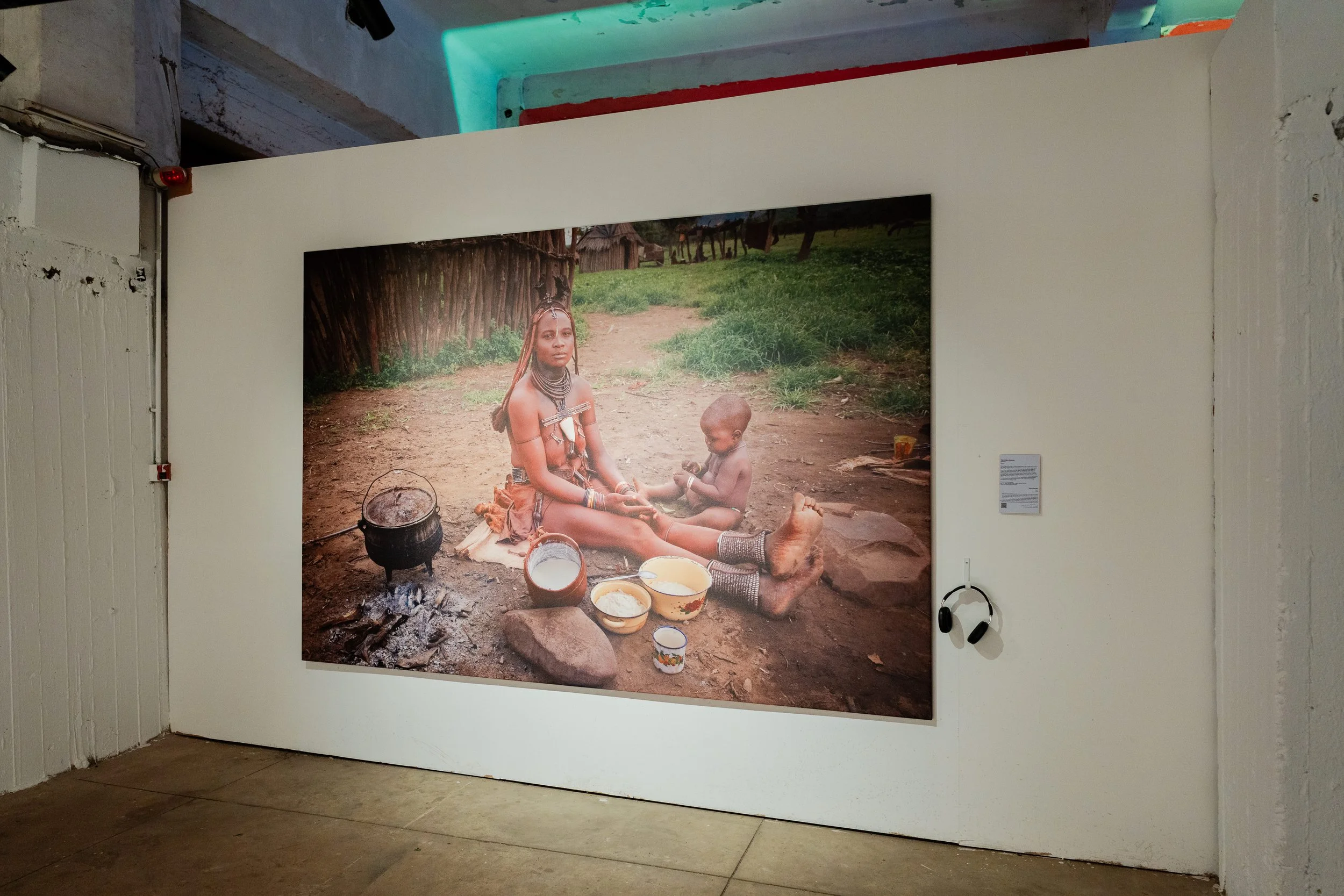BEYOND THE PLATE: WHAT THE WORLD EATS
A multi-sensory exhibition curated by WHEN WE EAT
featuring artwork from"What I Eat: Around The World In 80 Diets" by Peter Menzel & Faith D'Aluisio
WHEN WE EAT, we learn to observe the factors that shape our daily consumption, from busy schedules to childhood routines, to societal structures and geopolitical circumstances. We explore the differences that, though sometimes small, create major gaps between the diets of even the closest neighbors, from family structures, to hobbies and occupational needs. WHEN WE EAT, we highlight the role media plays in forming & reforming culinary culture over time, in documenting & carrying on culinary heritage, in raising awareness about the struggles and global issues affecting food & consumption. WHEN WE EAT, we challenge ourselves to reflect on the role of food in shaping personal and collective identities to reach a deeper understanding of the world’s diverse eating habits and lifestyles.
This multi-sensory immersive experience tells a story that highlights the versatility of the world's diets, exploring the various factors that influence them from abundance and scarcity, to rituals, routine, culture & beliefs.
Abundance & Scarcity:
Food is more than cravings, it is access & control.
WHEN WE EAT, we learn about the forces that fill or empty our tables, the cycles of plenty and want, and the resilience that sustains communities through both.
Culture & Belief:
Food is more than sustenance — it is culture and identity.
WHEN WE EAT, we learn about the different cultural perspectives that shape our food and consumption habits, and the deep-rooted beliefs that guide our daily lives.
Ritual & Routine:
Food is more than nourishment — it is the habit that connects us.
WHEN WE EAT, we learn how daily practices become traditions, how simple gestures carry meaning, and how shared meals anchor us in the rhythm of life.
Author's Statement - Peter Menzel & Faith D'Aluisio:
For over two decades we ate our way around the world many times over to produce works of journalism that compare and contrast what and how and why we eat what we eat, from one culture to the next. Our project What I Eat: Around the World in 80 Diets, invites readers to explore the lives of people around the world to see how their own diets compare. Our interest goes further than a worldwide cultural journey with a camera and a pen: At this point in the world's human history, medical advances should crown this time as the pinnacle of health and wellness. Where we live—the United States—the richest country in the world, we spend more than twice as much per person on health care than any other country on the planet, but many U.S. citizens are struggling with poor health, largely because of their eating habits. In the U.S., dietary choices and inactivity contribute significantly to four out of the six leading causes of death. In What I Eat, we document the growing impact of the globalization of food, and examples of both healthy and not-so-healthy eating. All contribute to both a better understanding of diet, and of culture.
Over time we ourselves have learned to eat differently—to eat what we want, but more moderately. And we avoid highly processed foods, and excess sugar.
What will be the take-away messages for you?
Featured Artwork
-
![]()
Bruce Hopkins
New South Wales, Australia
February
Bruce Hopkins, a Bondi Beach lifeguard, with his typical day's worth of food. Hopkins eats moderately and rarely - if ever - eats fast food. He drinks alcohol only when he and his wife go to dinner with friends.
At the time of the photograph
age: 35 height: 6ft. (1.82m) weight: 180 lbs. (81.6kg)
Typical daily caloric intake: 3700 kcals
-
![]()
Alamin Hassan
Dhaka, Bangladesh
December
Alamin Hasan, a porter at the Kamalapur Railway Station, with his day's worth of food. His father left the family a few months ago, and his mother is struggling under the weight of a house loan that couldn't be paid back. Alamin says that there wasn't enough to eat, so he jumped on the top of a train in the railway station in Rangpur and traveled south to Dhaka to find work. He sleeps on a bench in the train station and carries luggage for passengers. With the coins he earns, he buys food from the local sidewalk vendors but there is always the danger that older boys and official train coolies will beat him and steal his money.
At the time of the photograph
age: 12 height: 4ft. 7in. (1.43m) weight: 68 lbs. (30.8kg)
Typical daily caloric intake: 1400 kcals
-
![]()
João Agustinho Cardoso
Manacapuru, Brazil
November
João Agustinho Cardoso, a fisherman, in his floating house on a branch of the Solimoes River with his typical day’s worth of food. João’s new house has no electricity and the toilet is simply the end of the wood logs on which the house floats. The river water isn’t potable without boiling, but is teeming with fish, including piranha, which can make swimming during the early morning or evening an adventure. The curimata in the photo is just one of dozens of species of fish that makes its way onto João’s table. Absent from his daily diet are any alcoholic or caffeinated beverages, eschewed by his Seventh-day Adventist religion.
At the time of the photograph
age: 69 height: 5ft. 2.5in (1.61m) weight: 140 lbs. (63.5kg)
Typical daily caloric intake: 5200 kcals
-
![]()
Abdel Karim Aboubakar
Eastern Chad
November
Abdel Karim Aboubakar, a Sudanese refugee, with his day's worth of food in the Breidjing Refugee Camp in eastern Chad near the Sudanese border. He escaped over the border from the volatile Darfur region of Sudan into eastern Chad with his mother and siblings, just ahead of the Janjawiid militia that were burning villages of ethnically black African Sudanese. Like thousands of other refugees, they were accepted into the camp program administrated by the Office of the United Nations High Commissioner for Refugees (UNHCR). Their meals are markedly similar to those they ate in their home country—there's just less of it. They eat a grain porridge called aiysh, with a thin soup flavored with a dried vegetable or sometimes a small chunk of dried meat if Abdel Karim's mother has been able to work in a villager's field for a day or two.
At the time of the photograph
age: 16 height: 5ft. 9.5in (1.82m) weight: 110 lbs. (49.8kg)
Typical daily caloric intake: 2300 kcals
-
![]()
Cao Xiaoli
Shanghai, China
June
Cao Xiaoli, a professional acrobat, balances on one hand with her day's worth of food at Shanghai Circus World. Cao Xiaoli lives in a room with nine other girls. She started her career as a young child, performing with a regional troupe in her home province of Anhui. Now she practices five hours a day, attends school with the other members of her troupe, and performs seven days a week. There’s no time for dinner. She eats lunch in the cafeteria but savors her meals when her mother visits—at Pizza Hut or a local Chinese restaurant.
At the time of the photograph
age: 16 height: 5ft. 2in (1.58m) weight: 99 lbs. (44.9kg)
Typical daily caloric intake: 1700 kcals
-
![]()
Lan Guihua
Sichuan Province, China
June
Lan Guihua, a widowed farmer, in front of her home with her typical day’s worth of food in Ganjiagou Village. Her farmhouse is tucked into a bamboo- forested hillside beneath her husband’s grave, and the courtyard opens onto a view of citrus groves and vegetable fields. Although homegrown vegetables and rice are her staples, chicken feathers and a bowl that held scalding water for easier feather plucking are clues to the meat course of a special meal for visitors. In this region, each rural family is its own little food factory and benefits from thousands of years of agricultural knowledge passed down from generation to generation.
At the time of the photograph
age: 68 height: 5ft. 3in (1.61m) weight: 121 lbs. (54.8kg)
Typical daily caloric intake: 1900 kcals
-
![]()
Maria Ermelinda Ayme Sichigalo
Central Andes, Ecuador
September
Maria Ermelinda Ayme Sichigalo, a farmer and mother of eight with her typical day’s worth of food in her adobe kitchen house in Tingo village. With no tables or chairs, Ermelinda cooks all the family’s meals while kneeling over the hearth on the earthen floor, tending an open fire of sticks and straw. Guinea pigs that skitter about looking for scraps or spilled grain will eventually end up on the fire themselves when the family eats them for a holiday treat. Because there is no chimney, the beams and thatch roof are blackened by smoke. Unvented smoke from cooking fires accounts for a high level of respiratory disease and, in one study in rural Ecuador, was accountable for half of infant mortality.
At the time of the photograph
age: 37 height: 5ft. 3in (1.61m) weight: 119 lbs. (53.9kg)
Typical daily caloric intake: 3800 kcals
-
![]()
Marcus Dirr
Endingen, Germany
March
Marcus Dirr, a master butcher with one day's worth of food in his shop in Endingen, near Freiburg im Breisgau. Germans are among the biggest meat eaters in Europe, but eat slightly less meat than in decades past.
At the time of the photograph
age: 43 height: 5ft. 9in. (1.79m) weight: 160 lbs. (72.5kg)
Typical daily caloric intake: 4600 kcals
-
![]()
Robina Weiser-Linnartz
Cologne, Germany
March
Robina Weiser-Linnartz, a master baker and confectioner with her typical day’s worth of food in her parent’s bakery. She’s wearing her Bread Queen sash and crown, which she dons whenever she appears at festivals representing the baker’s guild of Germany’s greater Cologne region. At the age of three, she started her career in her father’s bakery, helping her parents with simple chores like sorting nuts. Her career plan is to return to this bakery, which has been in the family for four generations, in a few years.
At the time of the photograph
age: 28 height: 5ft. 6in. (1.70m) weight: 144 lbs. (65.3kg)
Typical daily caloric intake: 3700 kcals
-
![]()
Sitarani Tyaagi
Ujjain, India
April
Sitarani Tyaagi, an ascetic Hindu priest, with his typical day’s worth of food at an ashram. Sitarani Tyaagi is one of thousands of ascetic Hindu priests— called Sadhus—who walk the country of India and receive food from observant Hindus. He eats one meal per day and has water for the other two meals. He has a small pot that he carries with him for water. Offer him more food than a plateful, and he will kindly say, "no thanks."
At the time of the photograph
age: 70 height: 5ft. 6in. (1.70m) weight: 103 lbs. (46.7kg)
Typical daily caloric intake: 1000 kcals
-
![]()
Akbar Zareh
The province of Yazd, Iran
December
Akbar Zareh with his typical day’s worth of food at his bakery. The son of a baker, he began working full-time at age 10 and regrets that he didn’t attend school and learn how to read and write. By working 10 hours a day, every day of the week, he has sent his four children to school so they don’t have to toil as hard as he does. The product of his daily labor is something to savor—his fresh, hot loaves are mouthwatering and tasty. After baking in the tandoor clay ovens, most of the rounds of fresh bread are dried and broken into bits and sold as cracker bread.
At the time of the photograph
age: 48 height: 5ft. 3in. (1.61m) weight: 143 lbs. (64.8kg)
Typical daily caloric intake: 4900 kcals
-
![]()
Riccardo Casagrande
Rome, Italy
July
Riccardo Casagrande, a Roman Catholic friar and gastronome, in the San Marcello al Corso church dining hall in, with his typical day’s worth of food. For over 20 years he has overseen the kitchen, the rooftop garden, and the basement wine cellar for the friars and priests living in the church complex near Rome’s Spanish Steps. Between stints saying mass in the beautiful San Marcello al Corso in Rome, he is in charge of his fellow brothers' wine cellar, and oversees the cooks. Traditional Italian food is served family style in the brothers' large dining room.
At the time of the photograph
age: 63 height: 5ft. 8.5in. (1.79m) weight: 140 lbs. (63.5kg)
Typical daily caloric intake: 4000 kcals
-
![]()
Takeuchi Masato
Nagoya, Japan
June
Takeuchi Masato, a professional sumo wrestler whose ring name is Miyabiyama (meaning “Graceful Mountain”), with his day's worth of food in the team’s practice ring. Miyabiyama’s stable runs through a brutal three-hour practice— sweaty, combative, and silent. His food may not look like enough for a 400-pound man, but it maintains his weight and gives him energy for the ring. When he isn’t in intensive training before a match, he is wined and dined nightly by sponsors. The portrait is a composite, taken on two consecutive days, as the sumo association wouldn’t allow Miyabiyama to be photographed during practice. He is one of the largest of the Japanese sumos and eats now to maintain his weight rather than to gain it, unlike the younger, smaller wrestlers in his stable who are eating a lot to pack on weight.
At the time of the photograph
age: 29 height: 6ft. 2in. (1.88m) weight: 400 lbs. (181.4kg)
Typical daily caloric intake: 3500 kcals
-
![]()
Noolkisaruni Tarakuai
Narok, Kenya
January
Noolkisaruni Tarakuai, the third of four wives of a Maasai chief with her day's worth of food during a severe drought outside her house in a Maasai village compound. Noolkisaruni has her own house for sleeping and a windowless cooking house with earth and dung chinked into the walls. Maasai wealth is derived from the cattle and land owned, and the number of children born to support the family business: cattle and goats. She is photographed here with her day's worth of food: largely maize meal and milk. The fallen tree on which her food rests was knocked down by a marauding wild elephant. Two months after this photo was taken, the drought left only 50 of the family’s 400 cattle alive.
At the time of the photograph
age: 38 height: 5ft. 5in. (1.67m) weight: 103 lbs. (46.7kg)
Typical daily caloric intake: 800 kcals
-
![]()
Viahondjera Musutua
Namibia
March
Viahondjera Musutua, a Himba tribeswoman, sits outside the house at her father’s village with her youngest son and her typical day’s worth of food. The 23-year-old mother of three lives in a small village a seven-hour walk south from her father’s village but visits yearly to collect her share of the family corn. Her traditional dress includes a full body glaze of otjize, a cosmetic made of ground ochre, butterfat, and plant resin. She wears a fertility necklace and other jewelry made with leather and metal beads, a goatskin leather skirt she made herself, and an erembe, the traditional Himba headdress of married women. The hairstyles and adornments of both men and women change according to their stage of life.
At the time of the photograph
age: 23 height: 5ft. 8in. (1.76m) weight: 160 lbs. (72.5kg)
Typical daily caloric intake: 1500 kcals
-
![]()
Abdul-Baset Razem
East Jerusalem, Palestine
October
Abdul-Baset Razem, a Palestinian guide and driver in his extended family's backyard olive orchard with his day's worth of food in the Palestinian village of Abu Dis. Makloubeh, a crusty-bottomed rice casserole with vegetables and meat, is a family favorite. Food transportation and availability is tied to political circumstances.
At the time of the photograph
age: 40 height: 5ft. 6in. (1.70m) weight: 204 lbs. (92.5kg)
Typical daily caloric intake: 3000 kcals
-
![]()
Lin Hui-wen
Taipei, Taiwan
December
Lin Hui-wen, a street food vendor, with her typical day’s worth of food at a night market in Taipei. Hui-wen cooks with her husband now, but before they married she cooked with her mother and her younger brother. “We steep the luwei broth slowly for three or four hours to blend the flavors,” says Hui-wen, “then the food is cooked in the broth.” She makes the broth in concentrated form and then brings it to the food stall, where they mix it with water and heat it. “I hire someone to cut up the vegetables,” she says. Her kitchen helper is from Vietnam.
At the time of the photograph
age: 32 height: 5ft. 2in. (1.58m) weight: 121 lbs. (54.8kg)
Typical daily caloric intake: 2700 kcals
-
![]()
Head Monk
Tibetan Plateau
June
The head monk of a monastery with his typical day’s worth of food in the Tibetan Plateau. The monks were open about their diet, which includes butter tea and hand- made noodles, but asked that we not disclose his name or the location of their monastery.
At the time of the photograph
age: 45 height: 5ft. 5in. (1.67m) weight: 158 lbs. (71.6kg)
Typical daily caloric intake: 4900 kcals
-
![]()
Karsal
Tibetan Plateau
June
Karsal, a nomadic yak herder, with his typical day’s worth of food inside the family’s yak-wool tent on the Tibetan Plateau. A pile of dried yak dung used for fuel looms in the background. The family rarely eats the yaks that supply them with milk, wool, and cooking and heating fuel in the form of dung. Instead they eat dried mutton from their flock of sheep.
At the time of the photograph
age: 30 height: 5ft. 6in. (1.70m) weight: 135 lbs. (61.2kg)
Typical daily caloric intake: 5600 kcals
-
![]()
Samuel Tucker
Maine, USA
March
Samuel Tucker, a lobsterman, with his typical day’s worth of food in front of his boat at the Great Diamond Island dock in Portland. Sam works the lobster boat by himself, saving on labor, but in the summertime his son Scout comes along. Sam’s state license restricts his traps to the bay, where he averages only one lobster for every two traps. After paying for fuel and bait, there’s not much profit. He supplements his income with fish auction commissions, and his family’s diet with venison culled from the island’s deer population.
At the time of the photograph
age: 50 height: 6ft. 1.5in. (1.88m) weight: 179 lbs. (81.1kg)
Typical daily caloric intake: 3800 kcals
-
![]()
Ahmed Ahmed Swaid
Sanaa, Yemen
April
Ahmed Ahmed Swaid, a qat merchant, sits on a rooftop in Sanaa, Yemen, with his typical day’s worth of food. Ahmed has been a qat dealer in the city souk for eight years. Although qat chewing isn’t as severe a health hazard as smoking tobacco, it has drastic social, economic, and environmental consequences. When chewed, the leaves release a mild stimulant related to amphetamines. Because growing qat is 10 to 20 times more profitable than other crops, scarce groundwater is being depleted to irrigate it, to the detriment of food crops and agricultural exports.
At the time of the photograph
age: 50 height: 5ft. 7in. (1.73m) weight: 148 lbs. (67.1kg)
Typical daily caloric intake: 3300 kcals
-
![]()
Munna Kailash
Varanasi, India
April
Munna Kailash, a bicycle rickshaw driver, with his typical day’s worth of food outside the small home that he and his wife Meera share with their children in Varanasi, India. When he comes home for lunch he normally drinks a cup of tea, takes a short nap, and then heads back out into the steamy heat to find other patrons to cart from one location to the next, a job he does seven days a week.
At the time of the photograph
age: 45 height: 5ft. 6in. (1.70m) weight: 106 lbs. (48 kg)
Typical daily caloric intake: 2400 kcals
-
![]()
Saleh Abdul Fadlallah
Cairo, Egypt
April
Camel broker Saleh Abdul Fadlallah with his day’s worth of food at the Birqash Camel Market outside Cairo. Saleh commutes to work but eats many of his workday meals in the market cafe. Breakfast is usually ful medames (fava beans cooked with garlic and spices) and flat bread. Lunch is the main meal of the day. The specialty of the cafe is meat—often goat—cooked by the owner, a butcher-turned-restaurateur, who gets upset when the camels get too close and lick the tables.
At the time of the photograph
age: 40 height: 5ft. 8in. (2.43m) weight: 165 lbs. (74.8kg)
Typical daily caloric intake: 3200 kcals





